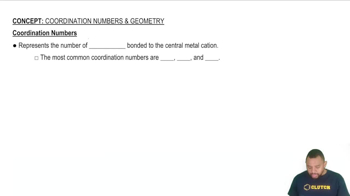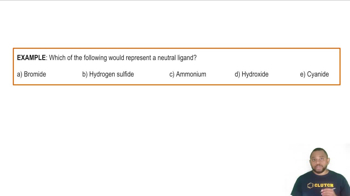The coordination number for the Al3+ ion is typically between four and six. Use the anion coordination number to determine the Al3 + coordination number in the following compounds: (a) AlF3 where the fluoride ions are two coordinate.
Ch.12 - Solids and Modern Materials
Chapter 12, Problem 66c
The coordination number for the Al3+ ion is typically between four and six. Use the anion coordination number to determine the Al3 + coordination number in the following compounds: (c) AlN where the nitride ions are four coordinate.
 Verified step by step guidance
Verified step by step guidance1
Identify the coordination number of the nitride ion, which is given as four.
Understand that the coordination number of the cation (Al^{3+}) must balance the coordination number of the anion (N^{3-}) in the compound.
Since the nitride ion (N^{3-}) is four-coordinate, each Al^{3+} ion must also coordinate with four N^{3-} ions to maintain the stoichiometry and charge balance in the compound.
Recognize that the coordination number of Al^{3+} in AlN is determined by the number of nitride ions it is bonded to, which is four in this case.
Conclude that the coordination number of Al^{3+} in AlN is four, matching the coordination number of the nitride ions.

Verified video answer for a similar problem:
This video solution was recommended by our tutors as helpful for the problem above.
Video duration:
3mWas this helpful?
Key Concepts
Here are the essential concepts you must grasp in order to answer the question correctly.
Coordination Number
The coordination number refers to the number of ligand atoms that are bonded to a central metal ion in a complex. It is a crucial concept in coordination chemistry, as it influences the geometry and stability of the complex. For example, a coordination number of four typically leads to a tetrahedral arrangement, while six results in an octahedral geometry.
Recommended video:
Guided course

Coordination Numbers
Ligands
Ligands are ions or molecules that can donate a pair of electrons to a central metal ion, forming coordinate covalent bonds. They play a significant role in determining the properties and reactivity of coordination compounds. In the case of AlN, the nitride ion (N^3-) acts as a ligand, coordinating with the Al3+ ion and influencing its overall coordination number.
Recommended video:
Guided course

Ligands Example
Ionic Compounds and Charge Balance
Ionic compounds are formed from the electrostatic attraction between positively charged cations and negatively charged anions. In determining the coordination number of Al3+ in AlN, it is essential to consider the charge balance between the aluminum ion and the nitride ions. The overall charge neutrality of the compound dictates how many nitride ions can coordinate with the aluminum ion.
Recommended video:
Guided course

Ionic Compounds Naming
Related Practice
Textbook Question
Textbook Question
The coordination number for the Al3+ ion is typically between four and six. Use the anion coordination number to determine the Al3 + coordination number in the following compounds: (b) Al2O3 where the oxygen ions are six coordinate.
Textbook Question
Both covalent-network solids and ionic solids can have melting points well in excess of room temperature, and both can be poor conductors of electricity in their pure form. However, in other ways their properties are quite different. (a) Which type of solid is more likely to dissolve in water?
